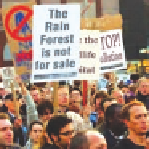Environmental Engineering Reference
In-Depth Information
Lobbyists
Lobbyists
Lawmaking body
Public hearing
Special-interest groups
Public advisory
Regulating enforcement body
Laws and
regulations
Legal action
Legal action
Lawyers
Lawyers
Environmental
organizations
Courts
Corporations and
small business
Laws and
regulations
Membership support
Boycotts
Individual
Purchase recyclable,
recycled, and environmentally
safe products
Recycle cans,
bottles, paper,
and plastic
Plant a
garden
Donate clothes
and used goods
to charities
Use water, energy,
and other
resources efficiently
Use mass transit,
walk, ride a bike,
or carpool
Figure 18-17
Individuals matter:
greatly simplified overview of how individuals and lobbyists for and against
a particular environmental law interact with the legislative, executive, and judicial branches of the U.S. gov-
ernment. The bottom of this diagram also shows some ways in which individuals can bring about environmen-
tal change through their own lifestyles. See the website for this topic for details on contacting your elected
representatives.
Passing an environmental law is not enough to
make policy. The next step involves trying to get
enough funds appropriated to implement and enforce
each law. Indeed, developing and adopting a budget is
the most important and controversial activity of the
executive and legislative branches.
Once a law has been passed and funded, the ap-
propriate government department or agency must
draw up regulations for implementing it. An affected
group may take the agency to court for failing to im-
plement and enforce the regulations or for enforcing
them too rigidly.
Politics plays an important role in the policies
and staffing of environmental regulatory agencies—
depending on which political party is in power and
which environmental attitudes prevail at the time.
Industries facing environmental regulations often put
political pressure on regulatory agencies and lobby to
have the president appoint people to high positions in
such agencies who come from the industries being
regulated. In other words, the regulated try to take
over the agencies and become the regulators—de-
scribed by some as “putting foxes in charge of the
henhouse.”







































